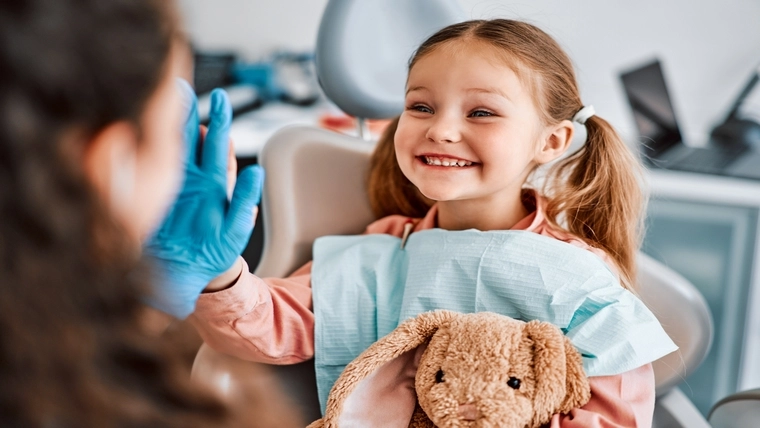
What is the Department of Pediatric Oral and Dental Health and What Diseases Does It Cover?
The Department of Pediatric Oral and Dental Health is a health unit that operates to protect children's oral and dental health, and to prevent and treat dental diseases. This department covers all needs related to dental development, oral hygiene and dental health of children from infancy to adolescence. The most common conditions in children such as tooth decay, gum disease, teething problems and jaw development disorders are treated in this department.
About the Department of Child Oral and Dental Health
The Children's Oral and Dental Health Department aims to minimize children's fear of the dentist and ensure that they have a healthy oral structure. The specialists working in this department provide training on protecting and developing children's dental health by using special approaches and treatment methods. In addition, protective measures are taken for children's oral and dental health in this department.
Who is a Pediatric Oral and Dental Health Specialist and What Are Their Duties?
Pediatric Oral and Dental Health Specialists are dentists who specialize in protecting and treating children's oral and dental health. These specialists monitor children's dental development, treat tooth decay, prevent and treat gum disease, and perform procedures such as tooth extractions and fillings. They also educate families and children on how to maintain children's oral hygiene.
What are the diseases treated in the Pediatric Oral and Dental Health Department?
Diseases treated in the Pediatric Oral and Dental Health Department include tooth decay, gum disease, teething problems, jaw development disorders, tooth discoloration and structural disorders, tooth trauma and malocclusion. In addition, genetic diseases and congenital anomalies that may affect children's oral and dental health are also treated in this department.
What are Pediatric Oral and Dental Health Examinations?
Children's Oral and Dental Health examinations are carried out regularly to monitor children's dental development and oral health, to diagnose potential problems early and to take the necessary precautions. These examinations are of great importance in reducing children's fear of the dentist and instilling the habit of protecting their dental health. The basic procedures and assessments carried out during these examinations are listed below:
- Detection of Tooth Decay: Decay in teeth is detected with special tools and visual examinations. Decay detected at an early stage can be treated with smaller and simpler interventions.
- Assessment of Gum Health: Although gum disease is rare in children, the condition of the gums is checked. If there are signs such as redness, swelling, bleeding or recession, early diagnosis of gum disease is provided.
- Checking the alignment and bite of the teeth: The alignment of the teeth and the bite of the upper and lower teeth are examined. Early diagnosis of orthodontic problems such as crowding or malocclusion (incorrect bite) increases the success of future treatments.
- Monitoring of Jaw Development: It is evaluated whether the child's jaw structure is developing correctly and whether there is any disorder in jaw growth. This allows for the prevention of jaw problems that may arise in the future with early intervention.
- Examination of Structural Defects of Teeth: Structural defects, cracks, abrasions or discolorations in teeth are examined during the examination. Early detection of such problems helps prevent aesthetic and functional problems.
- X-Ray Examinations: When necessary, X-rays are taken to see the root structure of the teeth, the jaw bone and the direction of tooth emergence. This allows problems that cannot be seen with the naked eye to be detected.
- Dental Cleaning and Plaque Control: Plaque and tartar accumulated on the teeth are cleaned. Dental cleaning is an important step in preventing cavities and gum diseases.
- Tooth Brushing Education: The child's tooth brushing habits are reviewed and correct brushing techniques are taught. In addition, families are guided in maintaining oral hygiene.
Children's oral and dental health check-ups play a vital role in ensuring that children have healthy teeth and prevent oral health problems. These check-ups should be done regularly every six months and any concerns about the child's dental health should be evaluated by a specialist.
What are the treatment methods applied in the Department of Pediatric Oral and Dental Health?
The treatment methods applied in the Pediatric Oral and Dental Health Department vary according to the age and health status of the children. The most common treatments applied in this department include fillings, root canal treatment, tooth extraction, gum treatments, preventive dental treatments (fissure sealants, fluoride application), orthodontic treatments and dental cleaning. In addition, in some cases, surgical interventions can be performed to support the development of children's teeth.
What is Done During a Child's Oral and Dental Health Examination?
During the Child Oral and Dental Health examination, the condition of the child's teeth is examined in detail. Tooth decay, gum disease, tooth alignment and jaw development are evaluated. When necessary, x-rays are taken to examine the root structure of the teeth and the jaw bone. In addition, the teeth are cleaned and the child is informed about tooth brushing techniques.
When Should You Go to the Pediatric Oral and Dental Health Unit?
The Children's Oral and Dental Health unit should be visited regularly from the first months when the child starts teething. In order to protect the oral and dental health of children, a dental check-up every six months is recommended. A specialist should also be consulted if symptoms such as tooth decay, bleeding gums, teething problems, tooth discoloration or bad breath are noticed. In addition, if the child experiences dental trauma, the dentist should be visited urgently.
